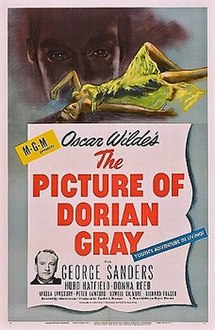
THRILL SCALE 1-10
5.5
HAVE I SEEN IT BEFORE?
I haven't seen any filmed versions of this story, but I was quite familiar with the plot.
BEST SEQUENCE
The climactic sequence during the last five minutes of the movie is quite memorable with some striking shots and visuals. Aside from that, anytime we see the painting it's pretty effective.
BEST LINE
"There's only one way to get rid of temptation, and that's to yield to it." - Lord Henry Wotton, the corrupting influence on Dorian Gray
ROTTEN TOMATOES SCORE
93%
ROTTEN TOMATOES CRITICS CONSENSUS
None available, for some reason
IMDB SYNOPSIS
"A corrupt young man somehow keeps his youthful beauty, but a special painting gradually reveals his inner ugliness to all."
THOUGHTS
- So, I feel like this is a pretty well known story, but just in case, spoilers ahead. As a wealthy young man of 22, Dorian Gray has his friend paint a portrait of him. While the painting is being finalized, Dorian makes a wish that he would never age physically, and instead the painting would age for him. Through some sort of ancient Egyptian mystical curse (or perhaps blessing), his wish is granted. Cut forward to 18 years later. Dorian still looks exactly the same, but he's been living a hedonistic, debaucherous lifestyle. So when we see the titular painting again, not only has the passage of time aged the person in the picture, but the lifestyle he's led has also turned it into a cruel, evil-looking old man. I haven't read the book by Oscar Wilde, so I don't know if the details are exactly the same, but that's how the movie plays out.
- And it really is a creepy painting, done in kind of a psychedelic way, which is interesting for a movie from 1945. If there's a chance you might watch this movie, try not to look it up beforehand. I had seen a picture of the painting already, but if I was completely surprised by it, I bet it would have been even more effective. If you don't plan on watching the movie, though, it's worth checking out a picture online. You can find one here, on Wikipedia.
- Adding to the impact, this is a black and white movie, but when we see the painting (both the original and the corrupted one), the shots are suddenly in colour. It's a pretty cool effect, although I wish we had gotten to see more of the painting as it was changing over the years. Then again, perhaps it was more effective to show the huge change which occurred over 18 years instead of a gradual progression.
- However, the movie isn't really very thrilling, and that might be partly due to the fact that they're quite coy about the evil deeds that Dorian has actually performed. This may be a result of the sudden jump to 18 years later, but we're never told what Dorian has been getting up to over those 18 years. Sex? Drugs? Violence? Overdue library fines? We can only assume. We do eventually see him kill a guy, but that happens after the painting has already reached its final form. And for the first act of depravity we see, before the 18 years pass, he kind of callously breaks off an engagement (with Angela Lansbury, who was nominated for a Best Supporting Actress Oscar). Like sure, that's not a nice thing to do, and she doesn't take it very well, but it's not necessarily evil.
- And interestingly, at least according to the IMDB trivia, Oscar Wilde's book was similarly written to obscure the bad things that Dorian has done to warp his painting so much. It was written in 1891, so perhaps Wilde was just showing restraint?
- Dorian was played by an actor named Hurd Hatfield, who I don't think I've seen in anything else. While he's supposed to be a man who maintains his youth and good looks while the painting changes, I thought he was pretty creepy looking from the get-go. He had dark, kind of soulless eyes, and his face was a bit cadaverous with high cheekbones. Plus, there are a lot of scenes which have an off-screen narrator describing Dorian's thoughts and feelings while Dorian himself just kind of wanders around or stares off at nothing, adding to the eeriness of his performance.
- Finally, as I mentioned, I never read the book, but we all know that Oscar Wilde was renowned for his wit. So while I don't know how much of it came from Wilde, or how much of it came from the screenwriter, I found this to be quite a witty movie. In particular, the character I quoted above, Lord Henry Wotton, played by George Sanders. He's always tossing out one-liners and cutting remarks, and he was a really fun character to watch
No comments:
Post a Comment